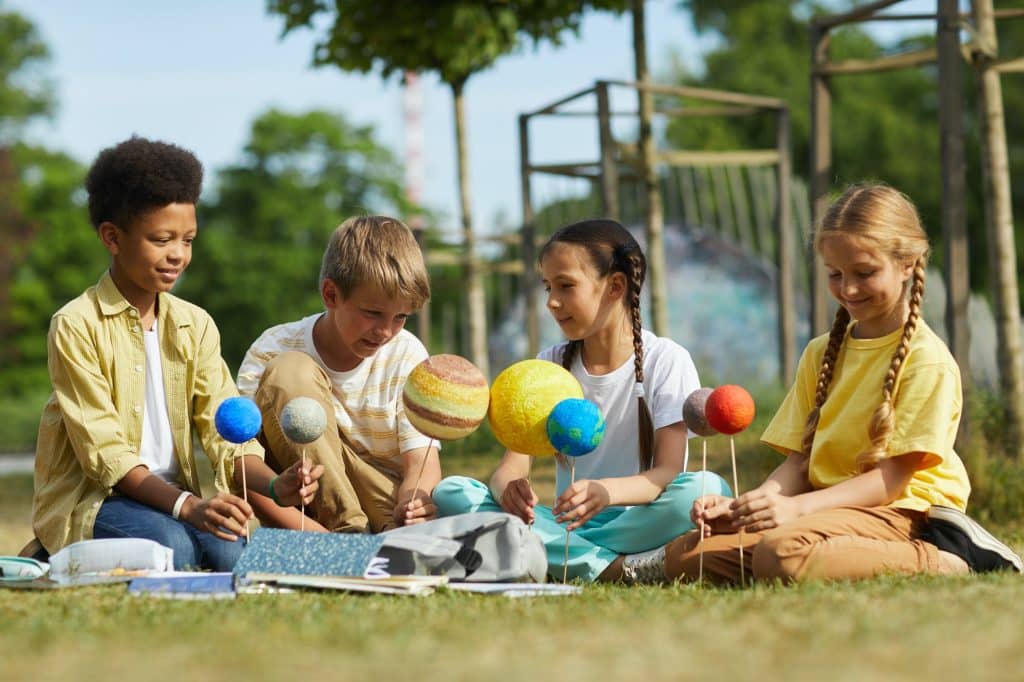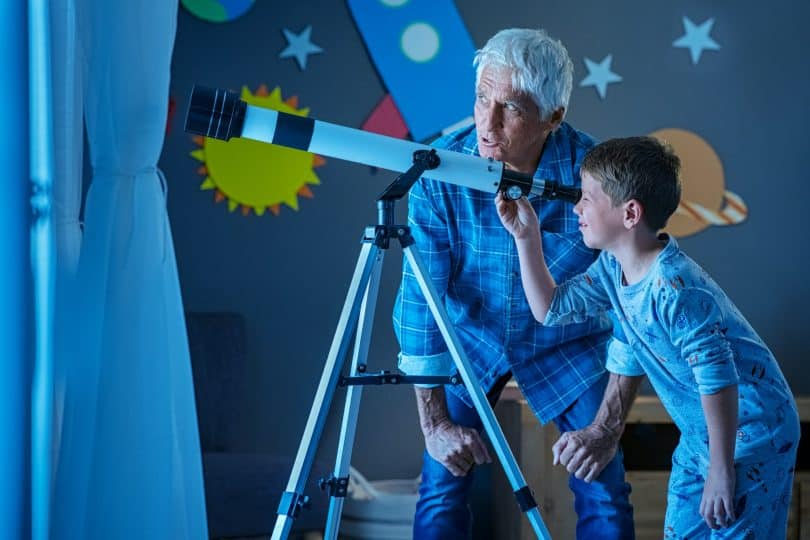The night sky has long held a certain fascination. Looking at stars and planets is a great way to get kids interested in science and start them on the track to varied and interesting careers.
While you might think it’s difficult to get started with astronomy, this is far from the case. Here are some interesting astronomy activities for kids that are fun for the whole family.

How Do I Start Learning Astronomy?
The first step in learning astronomy is to simply show an interest! Even the greatest scientists had to start somewhere, and this is with a desire to learn.
That said, the best starting point for all family members is to become familiar with the night sky using your naked eye. Spend a few clear nights looking at everything the sky has to offer, learning the placement of stars and other celestial objects.
If you already know some of their names, share these with your kids to get them interested.
Stargazing for Beginners
1. Make a Star Wheel
A good starting place is to make a star wheel.
There are various templates available online, but here is one from Sky & Telescope. Start with the sky map and then download the outer sleeve. You’ll need some kind of PDF viewer on your computer for these.
Each part fits on a single sheet of A4 paper, but you’ll need to do the following:
• Cut out the gray corners on the sky map.
• Cut out the large white oval in the middle of the outer sleeve.
• Fold the large white rectangle over on the outer wheel and staple it in place.
• Insert the sky map into the rectangle.
You use the map to align the date and time of your observation, and it’ll show you which stars are visible. You should be able to see these with the naked eye.
2. Sketch Constellations
Another great activity you can do without any equipment is sketching constellations. Famous constellations include the Big Dipper, Orion’s Belt, Little Dipper, and so on.
Draw a circle on a sheet of paper and note the time, date, and location. Draw in the most obvious stars (such as the North Star) and see if you can locate and draw the major constellations.
A star map book might help with this, but you can also find plenty of information for free online to get you started.
Drawing constellation charts across a period of months will help kids to understand how stars move across the sky based on the Earth’s rotation. You’ll be able to get them involved in a science lesson without them even realizing!
3. Learn the Stages of the Moon
The moon is perhaps the most obvious entity in the night sky. You can easily see it without any equipment, but using a telescope or binoculars will help you to see its details.
But for learning the moon’s stages, you can just use your naked eye. There are 8 stages in the moon cycle:
• New moon
• Waxing crescent
• First quarter
• Waxing gibbous
• Full moon
• Waning gibbous
• Last quarter
• Waning crescent
What’s more, the new moon of each month has its own name; you can find out more about these online.
A full moon cycle lasts 29 days, within which time you’ll see each stage quite clearly. Getting kids to draw and label these is a fun activity that takes advantage of the sky’s most obvious inhabitant.
4. Invest in Stargazing Tools
Realistically, you can do plenty of beginner’s astronomy without ever buying a telescope. However, investing in one will make the sky much more interesting. With a telescope you’ll be able to see things like galaxies, planets, and more.
You can find secondhand telescopes on a site like eBay for much less than they cost new. And in the early stages of stargazing, you don’t really need a high-powered, expensive telescope.
In fact, you can do astronomy using a pair of binoculars if you already own some. Use an interactive night sky map to locate planets, which you can then find with your stargazing equipment.
5. Visit a Planetarium
If you have access to one, a planetarium is a great way to get kids started with astronomy. The main benefit (along with visiting during the day) is that you’re not restricted by weather conditions.
Generally, planetariums shouldn’t charge entry, although they might ask for donations. Either way, they’re a great family day out and can teach you more than you might discover viewing the night sky.
6. Search for the Best Stargazing Location
While not strictly an activity, viewing stars in different locations can highlight issues such as light pollution to your kids. Using your backyard is always a good starting point, but traveling to a more rural location will give you a much better view of the sky.
A hill or raised area well away from built-up locations is easily the best place to view the night sky. What’s more, if an urban area is close enough, you can see the impact streetlights have on your ability to see.
In fact, if the sky is dark enough, you might even be able to see the Milky Way with your naked eye.

Conclusion
Stargazing for kids is an enjoyable way to help them learn about complex topics such as science. Importantly, there are plenty of resources for breaking down things like gravity, rotation, orbits, and so on, so there’s no need to not explain these to your kids.
Hopefully the activities above will provide you with a good starting point for getting your child interested in astronomy. You never know, you might learn something too!
Looking for more resources on how to get started with astronomy? Here are some of our favorite books, for both kids and adults.







